Despite the rise of social media, the proliferation of marketing “channels,” and the explosion of all things content, email marketing remains the single most-profitable way to reach your audience.
Of course, that doesn’t mean it’s easy. Far from it.
Many entrepreneurs and businesses fail to see the true potential of their email marketing programs for a variety of overlapping challenges. Chief among them: lack of data, poor coordination, and struggles with technology.
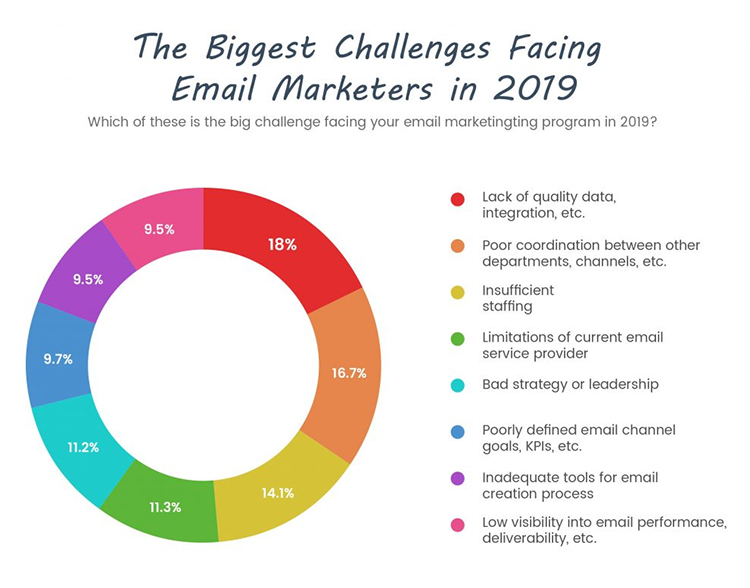
If any of the above resonates with you, not only are you not alone — you’re also in the right place. Throughout this guide, we’re going to explore how connecting a handful of missing strategies to your email marketing funnel can help you …
- Build a massive list of subscribers using popular opt-in tactics
- Produce campaigns that engage them along the path-to-purchase
- Sell through your new email marketing funnels and create customer loyalty
But first, a few words about definitions.
What is Email Marketing?
Email marketing is a digital marketing strategy used to send relevant and targeted emails to prospects and customers. Done right, it turns visitors into subscribers, subscribers into leads, and leads into buyers.
Done extremely well, email marketing turns your buyers into loyal, lifetime-value-generating customers.
From a benefits perspective, email marketing is …
- Cost-effective, alleviating budget constraints
- Personal, with exclusive perks and genuine relationships
- Authority building, as long as you send credible content
- Relatively easy to set up, with plenty of user-friendly tools
- Automated, saving you time, resources, and compounding results
What is an Email Marketing Funnel?
An email marketing funnel is a holistic approach email built on (1) onsite opt-ins and (2) a series of emails — or, multiple email campaigns — all with the goal of moving subscribers naturally and systematically through each stage of your sales funnel.
Typically, marketing funnels are structured around a sequence known as AIDA: awareness, interest, desire, and action.
Although we’ll explore top-of-funnel tactics — like how to build your list — email marketing is essentially a funnel within a funnel with its primary emphasis on “desire” (D) and “action” (A).
In fact, we can outline the process itself with three movements:
- Attract: Gather email subscribers via various opt-in tactics: e.g., landing pages, lead magnets, webinars, etc.
- Engage: Nurture subscribers via a series of targeted and well-timed emails that are (above all) relevant and valuable to them
- Convert: Guide subscribers either into qualifying themselves as leads (e.g., “book a demo” or “schedule a consultation”) or sell them on your initial product as well as upsells, downsells, and back-end offers

But, even a crystal clear definition and understanding the benefits still leaves a few questions unanswered. Namely, what’s the difference between an email marketing funnel and …
Email Marketing Versus Email Marketing Funnels
Email marketing describes a broad digital tactic that involves using emails to market a product or service. It’s possible to use email marketing only as a tool to send bulk emails, deals, or offers to your prospects.
However, that’s not the best way to run a successful email marketing strategy.
Instead, you need email marketing funnels to automate and personalize your campaigns with predefined sequences. These sequences (or, series) of emails are designed to target customers at the right time with the appropriate content, leading to better performance.
Sales & Marketing Funnels Versus Email Marketing Funnels
A sales or marketing funnel is a marketing strategy designed to turn prospects into loyal customers by funneling them through your entire business.

Building Your Email List: New Subscribers
If you’re not implementing tactics to grow your list, you’re missing a huge opportunity.
Email opt-ins represent some of the most lucrative traffic you could hope to send through your sales funnel. Why? Because it’s done on their terms.
Opt-ins represent naturally warm leads. If a visitor signs up to your list, they want to hear from you and likely to buy from you.
But don’t expect people to give you their email address for nothing. It takes some work on your part to make sure there is perceived value in what you’re offering. On top of this, you need to be using the right CTAs (call-to-action) and messaging to give prospects no choice but to hand it over.
Here are some top-level tactics you should consider when it comes to building your email list.
Landing Pages That ‘Squeeze’ the Email Outta Them
A squeeze page is a landing page, except it’s designed to serve one core function — to collect a user’s email address.
Generally, squeeze pages are designed to get to the point quickly. They are shorter than traditional landing pages with limited, yet still impactful content.
With a single offer — one all-consuming CTA — it’s very clear what the page is trying to do when you land on it.
After a squeeze page, comes a “Thank you” or confirmation page. Here, you’ll give your subscriber exactly what they asked for … or, exactly what they asked for plus surprising extras that align perfectly with exactly what they asked for:

Of course, for a squeeze page to work, you need to have some kind of incentive …
Lead Magnets That Attract Attention (and Their Emails)
A lead magnet is an incentive marketers offer prospects in exchange for their email address. On the squeeze page above, the lead magnet is the Free Funnel Cookbook.
Other types of lead magnets could be whitepapers, case studies, eBooks, reports, or videos. What’s more, these different lead magnets can be used in conjunction with each other all through your funnels. James Hepburn did with his high-ticket coaching funnel, which generated a 4,034% ROI:
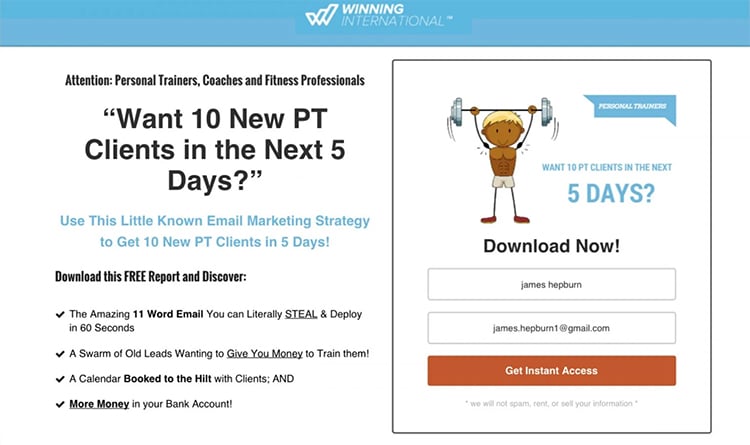
Webinars that Grab Attention and Spark Discussion
Webinars have become a popular choice among entrepreneurs and online businesses. And for good reason. They help you attract a highly targeted audience which helps you build a more qualified email list.
Just like any lead magnet, you can set-up a landing page for your webinar or use pop-ups across your site (sometimes called overlays or “modals”):
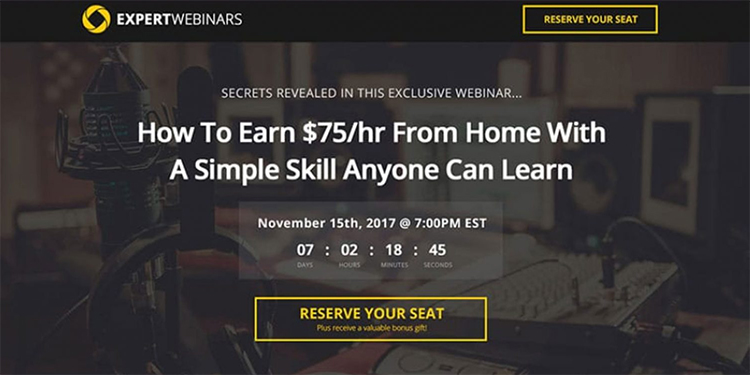

Once on your list, webinars also help you connect with your subscribers on a more personal level. It’s vital you don’t become complacent with webinar sign-ups and waste their time. Dig deep on a topic and give subscribers the opportunity to ask questions before, during, and after.
Regardless of which offer you use to collect addresses, take what happens next seriously …
Welcome Emails That (Actually) Feel ‘Welcoming’
Many marketers overlook welcome emails because they’re in a rush to start selling; however, your warm leads won’t stay warm for long if pushed too hard.
Obviously, it should include whatever lead magnet you used to get their email address.
Still, beyond just giving them what they asked for, the benefits of a welcome email are two-fold, both of which are somewhat subconscious:
- Your brand becomes more a helpful resource versus a salesperson
- You have the opportunity to give your marketing efforts a personal touch and establish a connection with your readers
Your welcome email should achieve the following as succinctly as possible:
- Introduce yourself or your brand (use “I” if possible)
- Briefly outline or discuss what users should expect from your future emails
- Major on the benefits you’ll be offering them, whether helping readers grow their businesses, achieve personal goals, or simply entertain them
Your welcome should be short, sweet, and to the point. That doesn’t mean it should be “fluff.”
While you shouldn’t necessarily start sending deals to your opt-ins off the bat, you can use your welcome email to present value to your users.
Turning Social Media Followers into Subscribers
Having thousands of followers is great, but are they engaging with your brand? And how much do these numbers actually impact your bottom line?
Most followers won’t see everything you post, so it’s important you keep scheduling regular posts that provide them a reason to sign up.
Make sure you add calls-to-action on each of your social media channels. This could be inviting your followers to sign up to your newsletter, access some content you’ve recently created, or register for an upcoming webinar.
Another way you can build your email list quickly is by hosting a social-media giveaway.
Giveaways aren’t about getting a ton of new subscribers. While that would be great, it’s better in the long-term for your business to focus on quality over quantity.
The best way to do this is by making sure your giveaway is targeted at your ideal audience, something they find appealing. Slick Products’ “influencer giveaway funnel” is a shining example: using an organic video originally posted by a motocross influencer, the brand created purchase-optimized Facebook Ads and drove traffic to a landing page to enter.
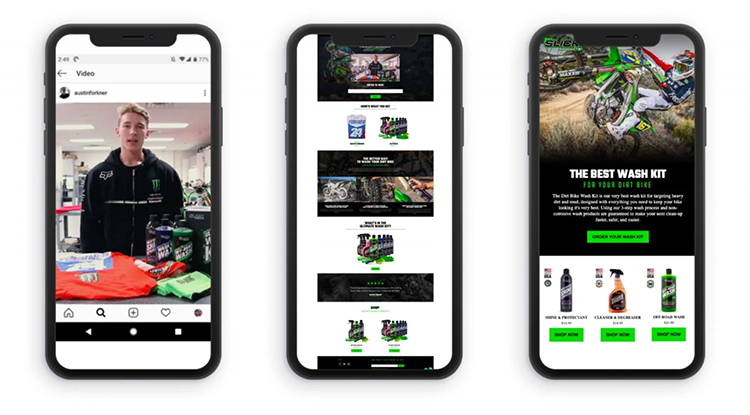
Launching Your Email Marketing Campaigns: Potential Customers
Despite popular belief, not all messages need to revolve around selling explicitly.
After all, sending a slew of “BUY NOW” emails will likely set off the spam alarm in the minds of your audience.
Instead, you need a series of captivating emails carefully crafted to nurture your leads, encouraging responses and clicks that will transform your opt-ins into lifelong customers.
Doing this requires some tactical coordination and the right platform …
Finding the Right Email Marketing Platforms (or, ESP)
An email service provider (ESP) is a company that helps marketers send email marketing messages to prospects via an email marketing platform.
Some have become all-in-one marketing and sales software that can help you build advanced funnels, above and beyond the ability to send marketing emails.
If you’re trying to work out which one is going to be right for you, here are some must-have features to consider.
Templates
Most tools offer you a wide range of templates to choose from. What you need to decide is how much you are going to rely on the pre-made templates (reducing your reliance on your tech team) and the level of customization capabilities you’ll require.
Tracking
Look for providers that give you a consolidated dashboard with all the metrics you need to measure your campaign performance. (We’ll explore what to track below.)

Automation
Make sure you have the ability to build workflows to schedule and send automated emails. More than a mere sequence, automation should (well) automatically adjust what’s sent based on (1) a subscriber’s interaction with your emails and (2) a subscriber’s onsite purchases.
Mobile-Friendly
All marketing should be mobile-responsive, including your emails. Choose a platform that makes it easy for you to design and see how your campaigns will look on mobile.
Database Management
Being able to easily see how many subscribers you have, where they are in the funnel, how they are converting at different stages of the funnel are just some of the reasons why you should ensure the platform makes it easy to manage your lists.
Once you’re familiar with the platform you’ve chosen, launching campaigns will become far less overwhelming.
The next hurdle is making sure you are paying close attention to the right metrics so you can measure how successful your campaigns are.
Capture and Analyze Important Email Analytics and Metrics
It’s important to understand what impact your email marketing efforts are making in your overall marketing and sales strategy. Plus, it’s also a good way to preempt any hurdle that may get in the way of achieving your goals.
Open Rates
The email open rate is a metric that defines how much of your emails from your campaigns are clicked and opened by your email lists.
Good email open rates vary from industry to industry … but what really matters is your relationship to your list.
How to Improve Your Open Rates
To improve your open rates, the first thing you should look at are your subject headlines.
A weak subject line will only deter the reader from clicking the email open.
When you consider how many emails we receive daily, most of them remain unread. Maybe because you don’t find it interesting from the subject line alone or it may look spammy because of the subject line.
You don’t have to possess awesome skills as a writer to create click-worthy email subject lines. While some are natural writers, most acquire this skill through study and practice until it becomes second nature.
Funnel Scripts is a great way to solve your subject line creation dilemma. You can easily create different email subject lines (i.e., headlines) with this awesome tool …

Simply enter the information asked in the fields, submit, and you’ve got yourself a number of subject line scripts to choose from.
Another tip to create a powerful email subject line is to personalize it by adding your customer’s name with the use of mail merge tags.
Clickthrough Rate
Once you get your subscriber to open the email, what’s next? If you’re following best practices, you should have one or multiple CTAs.
The clickthrough rate measures how many people have clicked on a link within your email.
How to Improve Your Clickthrough Rate
First, your CTA’s need to be easily seen.
They are the bread and butter of your email marketing funnel. Some emails can have very small text that readers have a hard time clicking on the call-to-action button.
Allow your customers to follow through and give you higher click-through rates by making links visible and accessible.
Second, they need to be compelling.
Here are some summarized tips from crafting call-to-actions that convert:
- Start with a compelling verb to make them act – Some common action phrases are get started, view or book demo, contact us, get in touch, learn more, discover, join, shop now, explore, and so on.
- Incorporate buzzwords that make it personal – Add more detail to the compelling verb to entice them even more and boost CTRs: show me my [product], get instant access to your free trial, let’s do it, or get your free [something] are just a few examples.
- Create urgency – Deadlines make us act. So, you can incorporate a deadline in your CTRs to add extra motivation: sign up before the end of [month], act before it’s too late, get your discount before it’s gone, don’t miss out, secure your spot before time runs out, limited quantities available.
As you can see, most of the examples are pretty simple. And that’s the way it should be with a call to action.
But there’s one last thing you should be doing to help you improve better CTRs: split testing.
Split testing is when you segment your audience and send them different versions of your email to find out which is the best performing.
Only change one element at a time. This will become the variable that will determine the cause of your campaign’s high or low performance.
Choose any variable, depending on what you want to troubleshoot. Test subject lines, headlines, and even offers. Once you get your CTRs humming, there’s still more work to be done.
Because having a high CTR doesn’t necessarily mean a high conversion rate.
Conversion Rate
Your conversion rate refers to the percentage of subscribers who complete a desired action after clicking through.
You should always pay attention to your conversation rate because it can give you insights into where there might be leaks in your sales funnel.
As long as your email platform and the pages you’re sending subscribers to are on the same platform, coordinating your email conversion rate with purchases is easy.
How to Improve Your Conversion Rate
First, what’s a good conversion rate?
The average landing page conversion rate is around 2.35%. The top 25% of sites are converting at 5.31% and above, while the top 10% are sitting around 11.45% and above.
But, those benchmarks are not from email subscribers. Given the value of email, an above-average email conversion rates are typically at least double other traffic sources.
If you’re seeing high click-through-rates but low conversion rates, here’s what you can do:
- Making sure the email offer is aligned to the audience – Ask yourself, “What did they originally opt in to receive? What is the clickthrough rate on those earlier emails? Are my follow-up offers directly related to that original offer?”
- Look at how you’re conveying value – This comes down to the copy on your page. Are you clearly outlining what value they will get from taking action? Focus on benefits and how it will solve your customer’s problems.
- Make them feel comfortable with the decision – Humans are naturally risk-averse. Things like social proof on how others have benefited from the same product or service, ratings and reviews, and money-back guarantees help us feel safe.
When you’re starting out, it’s easy to get distracted by the tech and design of the email itself. Get your metrics humming away nicely first, and then start introducing the added layers of things like automation that can take your email marketing campaigns to a whole new level.
Email Automation (It’s Not Complicated)
There are plenty of tools out there to automate your email marketing processes. Actionetics, in particular, can help you …
- Nurture your leads more efficiently
- Analyze and optimize your strategies for better results
- Decrease the time it takes for a lead to convert into a customer
- Reduce pressure on your internal resources
Being greeted by an email, regardless of knowing if it was an automated email, makes your subscribers feel good about their decision to sign up for your email list, and that’s why you need to have a warm and welcoming email to greet your new subscribers.
Actionetics lets you create and automate your emails for autoresponders, follow-ups, reminders and sales.
Automated Welcome Email
When someone subscribes to your email list, you need to acknowledge that. It marks the beginning of their journey to becoming a life-long customer or brand advocate.
And the best part is — it’s a very easy on-point trigger to set up. So you’ve got no excuses.
Automated Follow-Ups
Sending reminders or follow-ups to people in the email lists lets you know who among them are still interested to receive your content.
It’s also a great way to reconnect with them and build a good relationship. Start with a personalized subject line that grabs the readers’ attention and helps remind them that they’ve interacted with you in the past: “Bob, we’ve missed you.”
If you’re looking to clean up your email list, this is a good step to do to make sure which of those who do not open your emails should remain on your email list. Make sure that the email subject line in this type of email clearly states your intent to let them know what it’s for.
Automated Check-ins or Re-engagement Series
Sometimes you’ll notice drop-offs in your funnel.
To help incentivize a sense of interaction, consider a “check-in” message or ask for some form of feedback on your product or service.
Sometimes a steep discount or deal can represent the make or break moment for such users, perhaps giving them the last push they need to get back into your funnel.
Also, keep in mind that re-engagement campaigns represent a great opportunity to test new deals and CTA’s given that such users may otherwise drop out of your funnel altogether.
The amount of personalization and customization afforded by email marketing automation is staggering. You can craft an email marketing funnel that achieves just about anything given you have the time and a bit of creativity.
While crafting such emails initially may seem like a lot of legwork, consider how these messages can be automated time and time again, essentially allowing you to run your email marketing on autopilot while you get down to business.
But even if you’ve got your automation worked out and healthy-looking subscriber lists, you’ve still got to keep nurturing those lists.
And the way you do that is with content …
Relevant Content: Educate & Entertain
After you’ve gotten those precious subscribers to sign up for your email list you need to keep them interested and hooked to your emails, and the way you do this is by respecting their time.
A lot of brands fail at this stage because they abuse the relationship by forgetting what got them the email in the first place: by providing value.
Your subscribers don’t want to have constant emails trying to sell to them. While there’s still a place and time for new product drops and sales announcements, you need to focus your effort on creating content that is of interest to your subscribers that educates and entertains them.
Top content isn’t just a free ebook or a blog post. That’s the format. Top content is what makes your readers go “wow” and makes them want to share the article with their friends. It’s the value it provides.
Ask yourself: “Would I bookmark this blog post and share it with at least two other people because it’s so awesome?” Let’s call it the awesome hurdle: If your content doesn’t pass your awesome hurdle, then you’ve got a problem.
You should also send out educational messages that signal your authority within your space, display your knowledge and set yourself apart from the competition. These emails are relatively simple to craft if you’ve already got killer content on deck, such as an in-depth industry review or case study.
In your educational emails, exclusivity should be the name of the game.
Whatever you send out is something that your competition can’t provide or hasn’t unlocked. Present your education as a sort of secret or “insider scoop” that can’t be found anywhere else.
You can be clever with how you incorporate sales-themed call-to-actions in your content too.
For example, a business selling SEO software could provide an eye-opening case study conducted using their platform and urge readers to find out more (which leads them deeper into your funnel).
Selling Through Your Email Funnel: New Customers and Lifetime Value
To make this final section as actionable as possible, let’s take a look at five different examples of different email funnels and how they’ve used them to nurture prospects further down the funnel.
1. Ecommerce Emails
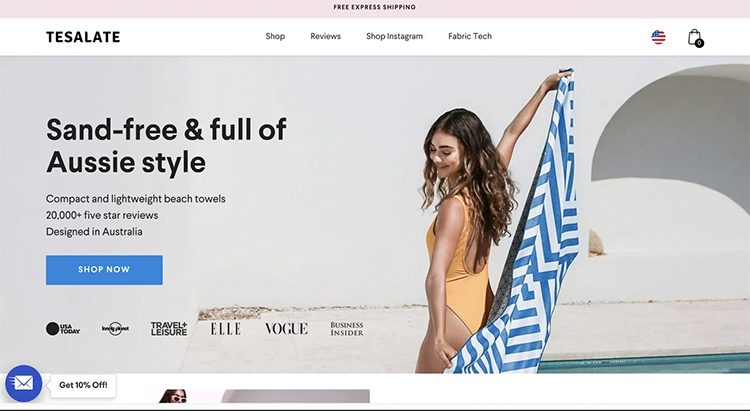
Tesalate’s email marketing funnel begins with a 10% discount:

Because of the time-sensitive code, the immediate goal is to turn its subscriber into a first-time purchaser.
Email 1: The promised discount
Subject Line: We love you and thanks 🙂
Sent: Immediately

Email 2: Convince with selling points, plus a discount reminder
Subject Line: What makes Tesalate unique?
Sent: One-day after sign up

Email 3: Time-based urgency
Subject Line: Last chance to get 10% off
Sent: Two-days later

Email 4: Purchased made. Thank you.
Subject Line: Thank you
Sent: Same day as purchase

Things to note:
- Short, succinct copy
- Timelines are tight: one-day apart
- Extremely clear call-to-action buttons
- Urgency is used to highlight missing out on the discount deadline
- The “Thank you” email is a completely different format, sent directly from the founder, and you’re invited to reply to the email with questions
2. Information Product Emails
On the surface, LadyBoss might look like an ecommerce business. That’s partly true because it does sell physical products. But don’t be fooled — those physical products are a gateway into a host of information products as well, which makes it a perfect email funnel to look at next …

Visitors can enter LadyBoss’ list through a variety of opt-ins but the primary offer on its homepage is the “$1 Challenge.”
Email 1: Meet Kaelin
Subject Line: Ready Or Not, The Raw Truth
Sent: Immediately

Email 2: A true story about the struggle
Subject Line: [Ch 2 of 11] It’s Like I Wasn’t Even There…
Sent: One-day later

Email 3: Finally, an offer
Subject Line: ⚠️WARNING: You’re NOT going to like THIS!!!!!!!
Sent: One-day later
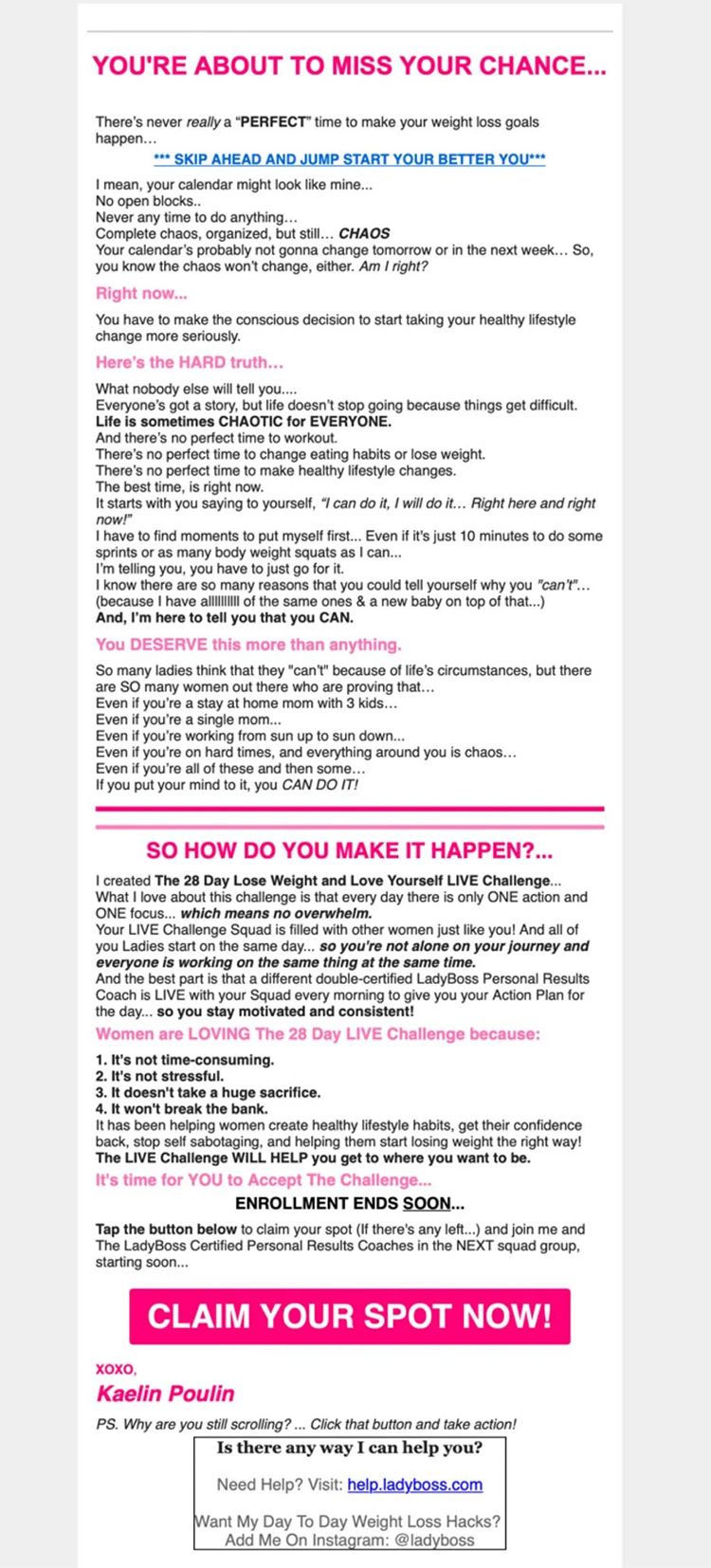
Emails 4 and Beyond
What follows is a front-row seat on how to structure an email marketing funnel.
LadyBoss has an 11 chapter sequence that mixes more raw honesty from Kaelin, storytelling, and special offers throughout:

3. B2B Lead Generation
In B2B marketing, a lead is anyone who’s given you their contact details, typically, in exchange for some valuable content.
Leads who meet certain requirements — like also providing their job title, company size, or budget — then become marketing-qualified leads (MQLs). After that, MQLs that show a legitimate interest in purchasing become sales-qualified leads (SQLs).
Given the length of that process — as well as how many people on the buyer side are involved in B2B purchases — email becomes all the more vital.
Make sure you (a) keep in touch with your new leads and (b) put effort into segmenting them based on which stage of the buying journey they’re in, so that (c) you’re providing highly-targeted and relevant content.

While SEMrush — a search-engine optimization SaaS — has plenty of content-driven opt-ins, instead let’s examine its free trial funnel.
Email 1: More than just a confirmation
Subject Line: Welcome to SEMrush! Please confirm your registration to get started
Sent: Immediately
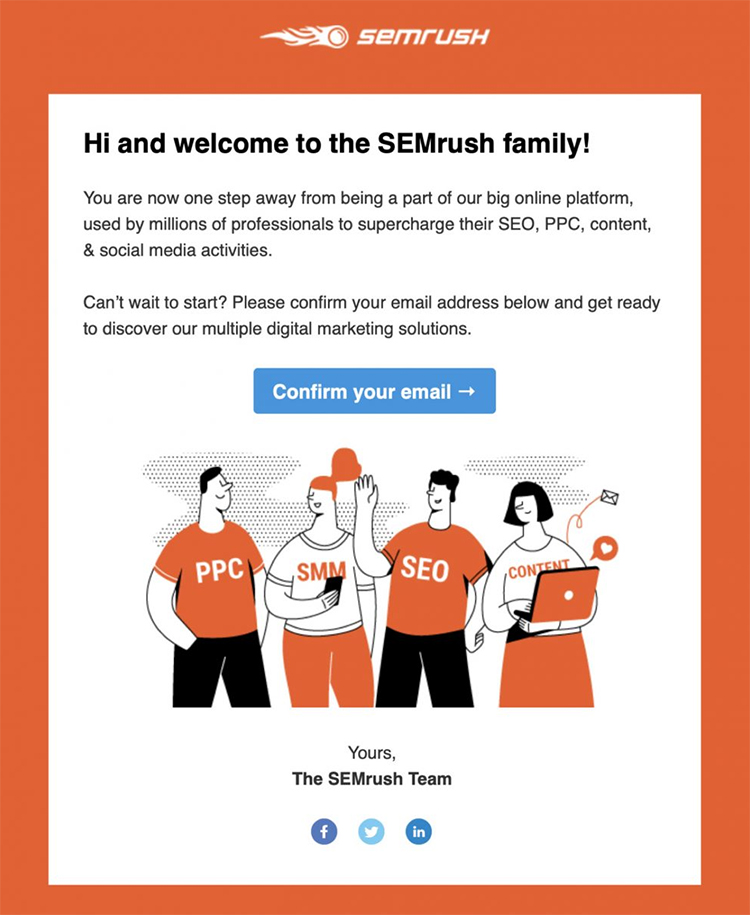

Email 2: End-of-trial offer
Subject Line: SEMrush May Discounts
Sent: Seven-days later

Email 3: Creating urgency
Subject Line: SEMrush [Month] Discounts
Sent: One-week later

Email 4: Special promotion to upgrade
Subject Line: SEMrush Christmas Offer
Sent: Seven-months later

Things to note:
- Set your new subscribers up for (eduational) success
- Even using automation can feel personal with names both to and from
- Discounts play a big part in B2B lead generation strategy
- But you should also leverage opportunities to upsell over time
- Again, urgency plays a key role in motivation
4. Freelancer Emails

Freelancer Ryan Robinson builds his email marketing funnel around nurturing new subscribers into becoming clients. In this scenario, the subscriber requested one of his downloadable templates.
Email 1: The promised download
Subject Line: Your templates from Ryan
Sent: Immediately

Email 2 and beyond: Providing consistent value
Ryan’s email marketing strategy for new subscribers focuses on providing weekly tips, strategies, and detailed insights on starting a side business.

Each time he sends one of these emails out, it gets the subscriber out of their inbox onto his website – which is where the extra conversion tactics begin.
It may be a longer nurturing process than the other examples we showed but if there is one thing we can see from Ryan’s email marketing success, is that his credibility and efforts in building authority with relevant content has paid off.
5. Coaching or Membership Emails

Facebook advertising program ADmission, kicks off its email funnel with a lead magnet also in the form of a pop-up.
Email 1: Three trainings, one email
Subject Line: Here’s your free FB ads training
Sent: Immediately

Email 2: Telling the truth and making it about the benefits
Subject Line: This may be exactly what you need
Sent: One-day later

Email 3: Proving it … “100% risk-free”
Subject Line: We believe in your dream
Sent: One-day later

Emails 4-6: Counter-intuitive best practices
Subject Lines: [Three emails exclusively focused on education]
Sent: Weekly

Email 7: “10 min consult”
Subject Line: We’ll tell you, honestly if ADMISSION is right for you.
Sent: Five-days later

Things to note:
- Over-deliver on value from the first email
- Sell your program when subscribers are most interested
- Mix educational content with promotional messages liberally
- End your sequence with a personal touch to nudge subscribers into buying
It’s Time: Start Your Own Email Marketing Funnel
Now that you understand the benefits of email marketing and the impact a funnel can have on your business, it’s time to start applying these ideas into your own.
Remember, the goal of an email marketing funnel is to move a prospect or new subscriber to become a loyal customer.
The first step is to build your email list using opt-in tactics and making sure you are crafting compelling offers and content. Then, it’s about launching highly targeted campaigns to relevant audiences and not being afraid to test and learn.
Plus, it doesn’t hurt looking into the email marketing platforms that already have some sales funnel templates to put you on the right track.






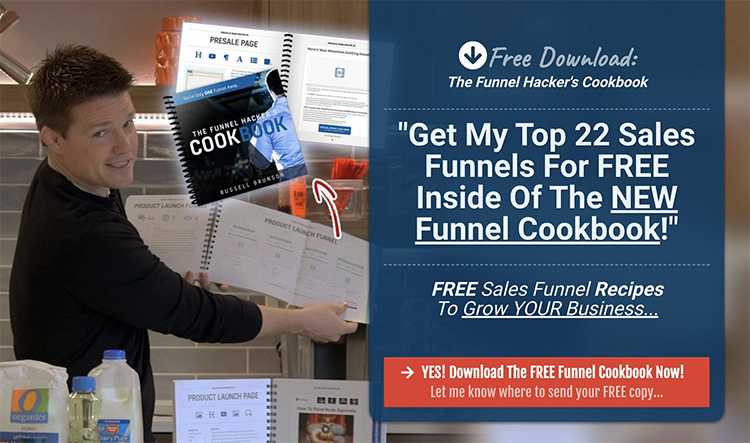
Hello, interesting post! Thanks for making us aware about your updated blog, "Email Marketing Funnels: The Missing Strategies to Build and Profit from Your List". I will stay connected with you for future posts. Thanks again and keep posting.
Wow!
Hope we're able to help along your journey!